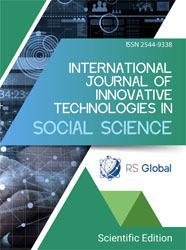VARIATIONS IN NO2 CONCENTRATIONS BEFORE, DURING, AND AFTER THE COVID-19 LOCKDOWN IN THE WILAYA OF ALGIERS
Abstract
Unplanned urbanization and industrialization are among the leading causes of air pollution in urban environments, with significant economic, social, and environmental consequences, posing threats to human health. Atmospheric pollution has been the subject of multiple studies worldwide, especially in developed countries. However, developing countries, including Algeria, face difficulties in taking appropriate measures to preserve air quality due to the lack of sufficient monitoring data. To address this problem, satellite remote sensing technology has been used to monitor the spatio-temporal evolution of pollutant emissions. This study focused on identifying high-pollution areas in the wilaya (province) of Algiers, characterized by intense urbanization and increasing economic and industrial activities. The impact of reductions in anthropogenic emissions during the Covid-19 pandemic lockdown on air quality was also examined. For this purpose, variations in NO2 concentrations in Algiers before, during, and after the lockdown were analyzed using Google Earth Engine (GEE) and data from the TROPOMI tropospheric monitoring instrument. The study focused on 11 selected sites across the wilaya, revealing that the highest NO2 concentrations were observed in densely populated and industrial areas such as Oued Smar, El Harrach, and Baraki, where heavy traffic combines with significant industrial activity. Reductions in NO2 levels were observed across the wilaya during the lockdown, attributed to the considerable decrease in mobility and industrial activities during the Covid- 19 pandemic.
References
Ahluwalia, V. K., & Malhotra, S. (2008). Environmental Science. Delhi, India: Ane Books India
Belhout, D. (2019). « Evaluation des émissions atmosphériques et modélisation de la qualité de l’air dans le grand Alger : scénarios à l’horizon 2030 (Doctoral dissertation)
Bourboulon, I. (1997). « Des villes asphyxiées par l’automobile. » Le monde Diplomatique, Décembre, p.18
CITEPA, 2011. Emissions dans l’air en France métropolitaine, http://www.citepa.org.
CITEPA, 2023. Résumé de la qualité de l’air dans le monde, http://www.citepa.org.
El Khoury, E., Ibrahim, E., & Ghanimeh, S. (2019). « A look at the relationship between tropospheric nitrogen dioxide and aerosol optical thickness over lebanon using spaceborne data of the copernicus programme ». In 2019 Fourth International Conference on Advances in Computational Tools for Engineering Applications (ACTEA) (pp. 1-6). IEEE.
He, W., Wang, Y., Zuo, J., & Luo, Y. (2017). « Sectoral linkage analysis of three main air pollutants in China's industry: comparing 2010 with 2002. » Journal of Environmental Management, 202, 232-241.
Ghasempour, F., Sekertekin, A., & Kutoglu, S. H. (2021). « Google Earth Engine based spatio-temporal analysis of air pollutants before and during the first wave COVID-19 outbreak over Turkey via remote sensing. » Journal of Cleaner Production, 319, 128599.
Glandus, L. M., & Beltrando, G. (2013). « Les déplacements urbains et la pollution de l’air dans des villes intermédiaires : enjeux politiques et environnementaux. » Norois. Environnement, aménagement, société, (226), 25-40.
Kemp, D. D. (2004). « Exploring environmental issues : An integrated approach. » London, United Kingdom: Routledge
Mabahwi, N. A., Leh, O. L. H., & Omar, D. (2015). « Urban air quality and human health effects in Selangor, Malaysia ». Procedia-Social and Behavioral Sciences, 170, 282-291.
Messaadi, I., & Raham, D. (2021). « étude méthodologique de la croissance urbaine en Algérie « (Doctoral dissertation, Université Frères Mentouri-Constantine 1).
ONS (Office National des Statistiques) (2016). Alger. http://www.ons.dz
ONS (Office National des Statistiques) (2017)
ONS (Office National des Statistiques) (2018)
OMS (Organisation mondiale de la santé) (2020). Allocution liminaire du Directeur général de l’OMS lors du point presse sur la COVID-19 - 11 mars 2020.
Parr,S., Wolshon, B., Renne, J., Murray-Tuite, P., Kim, K. (2020). « Impacts de la pandémie de COVID-19 sur la circulation: analyse à l’échelle de l’État de la séparation sociale et de la restriction d’activité », Nat. Hazards Rev., 21 (3).
Tella, A., & Balogun, A. L. (2022). « GIS-based air quality modelling: Spatial prediction of PM10 for Selangor State, Malaysia using machine learning algorithms. » Environmental Science and Pollution Research, 1-17.
Tella, A., & Balogun, A. L. (2021). « Prediction of ambient PM10 concentration in Malaysian cities using geostatistical analyses. » Journal of Advanced Geospatial Science & Technology, 1(1), 115-127.
Terrouche, A., & Ali-Khodja, H. (2016). « Caractérisation de la pollution de l'air par les particules et les éléments métalliques dans la ville de Constantine. » (Doctoral dissertation, Université Frères Mentouri-Constantine 1).
Wang, S., Chu, H., Gong, C., Wang, P., Wu, F., & Zhao, C. (2022). « The Effects of COVID-19 Lockdown on Air Pollutant Concentrations across China: A Google Earth Engine-Based Analysis. » International Journal of Environmental Research and Public Health, 19(24), 17056.
Xu, R., & Lin, B. (2017). « Why are there large regional differences in CO2 emissions? Evidence from China's manufacturing industry. » Journal of Cleaner Production, 140, 1330-1343.
Zitoun, M. S., & Tabali-Talamali, A. (2009). « La Mobilite Urbaine Dans L’agglomeratin D’alger: Evolutions Et Perspectives. ».
Views:
80
Downloads:
43
Copyright (c) 2025 Messaadi Ibtissem, Hamdouche Mourad, Lakhdar Amar

This work is licensed under a Creative Commons Attribution 4.0 International License.
All articles are published in open-access and licensed under a Creative Commons Attribution 4.0 International License (CC BY 4.0). Hence, authors retain copyright to the content of the articles.
CC BY 4.0 License allows content to be copied, adapted, displayed, distributed, re-published or otherwise re-used for any purpose including for adaptation and commercial use provided the content is attributed.















